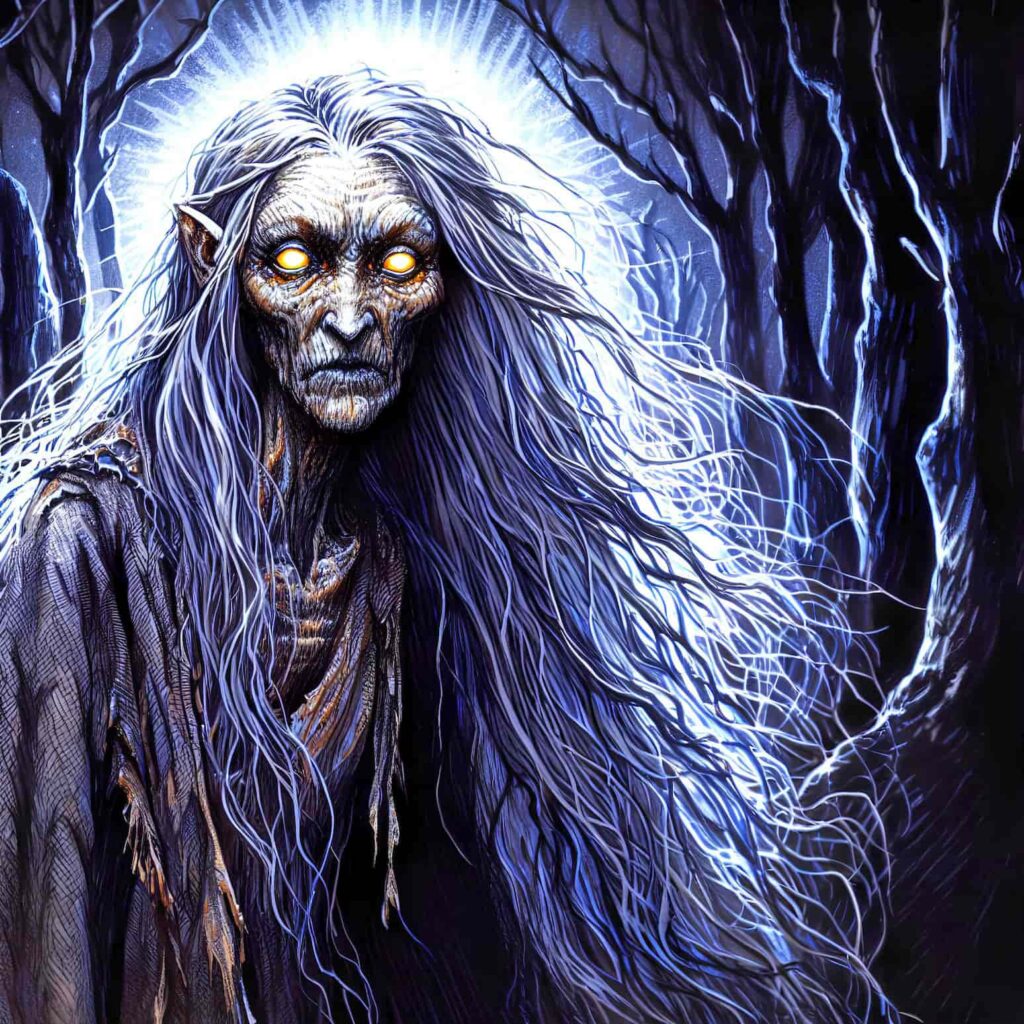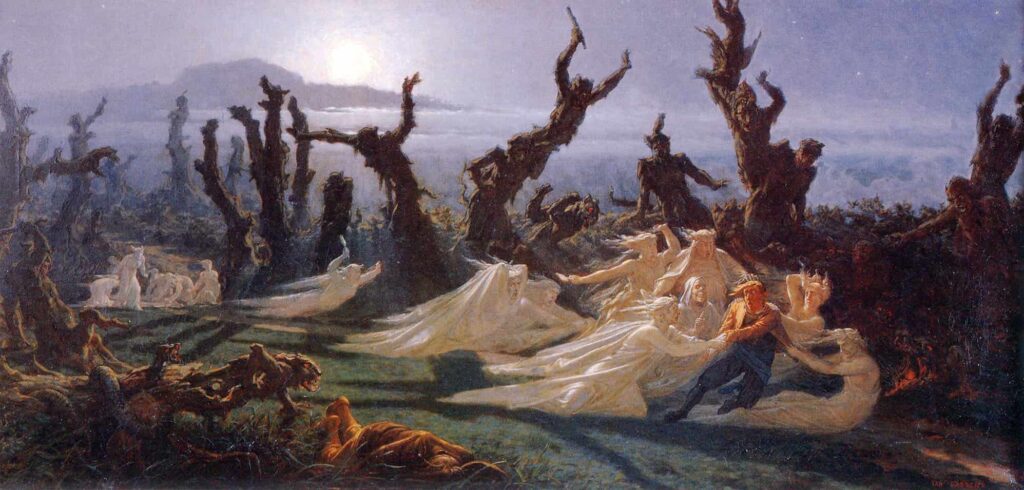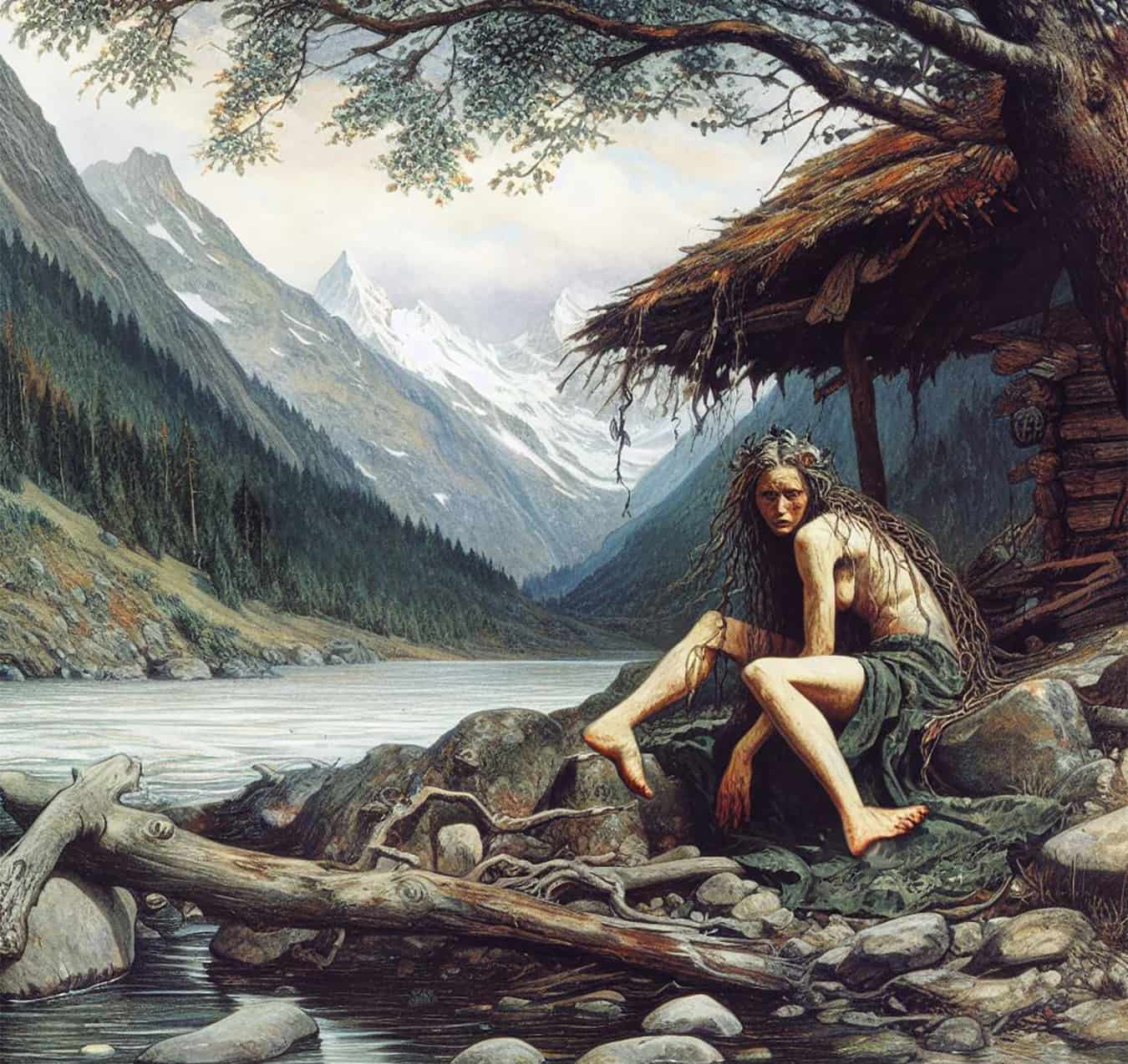- Banshees are solitary beings, often portrayed as hideous old women.
- Their mournful wails signify an impending tragic demise.
- Banshees bridge ancient Gaelic beliefs with modern European folklore.
Irish Celtic mythology has magical female characters such as banshees, banshies, and bean sí who are either sorceresses or messengers from the Otherworld (sidh, an original spelling of the Irish word sí). It’s related to other European mythical creatures including those from the Welsh and Norse traditions. Banshee in mythology is a solitary, old woman with loose, unkempt, and flowing gray hair. She wears a long, tattered robe and is often depicted barefoot. Her skin is deathly pale, and her features are gaunt and mournful. Her eyes are hollow, emitting an eerie, otherworldly glow.
Etymology of Banshee

The banshee goes by many distinct names across languages and time periods. Its most common form in English, “banshee”, comes from a 1771 text and it is a phonetic borrowing from Irish Gaelic.
“Woman of the sidh” translates directly from Irish Gaelic as “bean sidhe” (or “bean sí,” originally “ben síd”) and from Scottish Gaelic as “bean sith.” In Gaelic Celtic mythology, the name “sidh” (or “sí,” “síd,” “sith,” “sidhe”) referred to the Otherworld.
The word subsequently came to signify “hill, mound” (a portal to the realm of gods or death) and then “sidhe/sith” (sometimes mistaken with Aos sidhe) and, finally, “hill people” or “fairy” in English.
In Ireland, the banshee is known as “bean chaointe” (Scottish: “caointeach,” English: “keening woman“), which literally translates as “woman who wails funeral dirges.”
In southeast Ireland, the banshee is also known by a number of dialectal variations of the word “badhbh,” a phrase derived from “Badh” (formerly “Bodhb”), the name of a protective (or warrior) goddess in Celtic or medieval mythology, Bodb Derg.
Banshee in the Celtic Mythology of the Gaels

Although much of the sources originate from medieval Irish literature (written after the Christianization of Ireland), it is believed that the bean sí has Celtic roots.
The mixture of pagan and Christian notions in medieval writings makes it difficult to ascertain the original meaning of “bean sí.” Bean sí may have originally meant some kind of female-related “mystical or magical quality” (sí). Not until the eighth century did the term “bean sí” in writings come to mean “woman from the Otherworld.”
Occasionally, the Sidh shower their blessings upon deserving men, such as Conn and Bran Mac Febail, and transport them to the “Delightful Plain,” Mag Mell. Sometimes their apparition brings about disease that no medicine can treat, and without divine intervention, death follows.
The death of Muirchertach Mac Muiredaig features a banshee and her abilities in a story that has been Christianized on the surface. The lady in this narrative develops her powers outside of the sidh, before she is converted.
The queen from the Otherworld, Sin, has captivated the king with her beauty. She insists that he get a divorce and send his wife packing. If he so much as mentions her name (geas), he will be killed. With the might of her sorcery, the stones become lambs, water turns into wine, plants become pigs, and armies are created at her command. She also has the ability to create precious metals.
Banshee in the British Isles Mythology
All the folklore and beliefs of the British Isles (Ireland and Great Britain) center on the banshee. These myths were mostly transmitted orally (via stories, accounts, songs, and ceremonies) from one generation to the next. Scholars in the early 20th century compiled traditional stories and folklore about banshees, which had been subjects of belief since the Middle Ages (5th–15th centuries).
The Death Bringer

The association of banshees in folklore with the proclamation or portent of death is a defining feature of this mythical creature. The presence of a banshee was associated with death and combat in medieval stories and legends, serving as a portent of the afterlife in both Christian and pagan faiths. In today’s culture, the banshee is still a portent of death inside the home, usually due to natural reasons.
According to the most common belief, the position of the goddesses in Irish and Celtic mythology as bringers of death is where the traditions of banshees first arose. The ancient Irish custom and practice of funeral keening (vocal lament for the dead), Anglo-Saxon beliefs in fairies, medieval and modern beliefs in haunting female spirits (with ties to a particular family), and aos sidhe (the “people of the mounds”) legends are all frequently cited as possible sources for banshees.
Guardian of the Family
There was a banshee for every powerful Irish household. This mysterious entity would stick with the family no matter where they went.
“One of the most beautiful superstitions of Irish fiction is to assign to certain families of ancient lineage and distinguished rank, the privilege of a banshee, or domestic fairy, whose office is to appear in mourning to announce the approaching death of a member of that race.”
— Letters on Demonology and Witchcraft (1830) by Walter Scott, a Scottish historian and poet
A dark-clothed coachman led by a headless ghost often precedes the appearance of a banshee connected to a long-dead family. The dead person’s soul is retrieved by this coachman. Two Coldstream Regiment troops witnessed such a vehicle in London in January 1804. They were so shaken up by the sight of a headless lady walking up Birdcage Walk on the coach that they had to spend some time recovering there.
The lares of ancient Rome, with their roots in Etruscan mythology, were similar to the banshee in that they were worshiped as protection deities for individual households such as the Lar familiaris (“lar” from the Etruscan for “lord”).
Laundress

In County Galway and the surrounding areas in the west of Ireland, the banshee was said to purify clothing in a river in the 20th century. Like the death omen of the bean-nighe spirit in Scottish Gaelic mythology and the kannerezed noz in Brittany, this is a fable about a laundress who works at night (also known as Les Lavandières or Midnight Washerwomen).
There is a clear line between this current tradition and ancient Irish tales about the Celtic goddess Badb wiping the bloodstained robes of those doomed to die in battle.
Mourner
According to legend, the banshee may occasionally cry out the news of a death with a series of mournful chants, or “funeral chants.” Bean chaointe in Irish, caointeach (or caoineag) in Scottish Gaelic, and keening woman in English all describe banshee for this conduct.
These spontaneous vocal lamentations paid honor to the departed and their family in ancient Gaelic culture via the practice of mourners, which is where the term “funeral chants” comes from. This funeral custom, which may be seen in many different parts of the globe, is attested in medieval Ireland and Scotland. The Catholic Church in Ireland outlawed the practice, and it eventually died out. These (occasionally compensated) mourners would dress like the famous banshee, donning a long robe and displaying unbraided hair.
Screamer of Tragic Ends
In later legend, especially the oral tradition of the 20th century, the banshee foretells death with a shrill shriek or howl that jolts even the soundest sleeper up. This contemporary practice seems to be especially widespread in parts of Ireland, Scotland, and Wales that have been affected by non-Gaelic civilizations.
The banshee’s wail is unlike any other kind of human or animal scream and is more akin to a death rattle or the sounds of a woman giving birth. When heard in the home, this scream is a portent of a tragic end.
The banshee’s wailing is reminiscent of the screams of other revenant characters from medieval European tradition, who also presage death.
The Banshee’s Appearance

From these many reports, it is possible to infer a few defining traits of the banshee’s physical appearance.
- Solitary Being: In all depictions, the banshee seems to be alone.
- Hideous Old Woman: Unlike the historical Irish custom, in which ladies covered their long hair with a scarf, she is often portrayed as a horrible old lady who is extremely skinny and has hair that is loose and exposed. There are tales of banshees who comb their hair, or whose combs are taken by humans.
- Long Robe: The banshee is easily recognizable by her long gown, which is often of an antique design. The banshee is often seen without shoes. Legendary ghostly characteristics, such as her deathly white complexion or gruesome features, are occasionally included in descriptions.
Other Myths Related to the Banshee
There are some mythical creatures with similar features to the banshee.
Sluagh: The sluagh are wandering ghosts that appear in Irish and Scottish legends. Because of their destructive nature, mankind is warned not to let them into the Otherworld (including heaven).
Dame Blanche (White Lady): The White Lady in French mythology and the banshee have several characteristics, and their legends often intertwine. The present tale of the White Lady seems to have evolved from the older banshee myth. References to the White Lady and banshees appear in the mythology of England, Ireland, and Wales, suggesting that the tale of the White Lady had an impact on these countries. The Lady of the Bourbons’ palace, for instance, who arrived on the eve of the death of a noble family member, is often cited as an example of a White Lady who has been likened to a banshee in the country.
Other Characters: More similarities between the banshee and other beings may be drawn, such as those between Melusine (a mythic water sprite), Áine (the Irish goddess of summer), Aibell (an Irish guardian spirit), and Saint Brigid of Ireland.
References to Banshee in Modern Culture
Literature
- In Keeper of the Lost Cities by Shannon Messenger, elven healers can have banshees with them, which tell them if their patient is dying or in critical condition.
- Marigold (Elven Chronicles, #1) by Marya Ashworth, the protagonist, Marigold, encounters a boy being attacked by banshees in the forest.
Comics
- One of the X-Men in Marvel Comics can unleash a devastating scream. Banshee was his name and he debuted in 1967.
- Silver Banshee is a DC Comics supervillain and an adversary of Superman. She first appeared in 1987 and is known for her skeleton appearance and deathly cry.
- When the JAM infiltrates the flying aircraft carrier Banshee IV (depicted in the manga Yukikaze), the Fairy Air Force will shoot it down.
- Silky, a minor character in Kore Yamazaki’s manga The Ancient Magus’ Bride (2013), was formerly a banshee.
- The banshee first appears in the fourth volume of Touya Mikanagi’s manga Karneval (2009).
Paper-Based Role-Playing
- It’s a monstrosity from the Dungeons & Dragons 3.5 Monster Handbook II. In the original Dungeons & Dragons game, she is a wicked elf turned undead whose scream killed anybody who heard it. A “howling spirit” was another name for this beast. Games Workshop adopted this being and made it into an elf warrior in their games years later.
- Banshees are Eldar fighters in the Warhammer 40,000 world, introduced by Games Workshop in 1987. Their screams have the power to doom souls.
- Banshees are a kind of vampire kin in Warhammer.
Music
- Red Hot Chili Peppers‘ “do me like a banshee” is a line from their song “Suck My Kiss.”
- “Well, call of the banshee, hey hey” appears in Green Day‘s song “Peacemaker” off of their album 21st Century Breakdown.
- The Cranberries‘ “The Glory” lyrics sang: “Do you remember? Late in September, the banshee cry, when someone dies.”
- The Vision Bleak‘s song “The Call of the Banshee” references the legend of the banshee.
- Siouxsie and the Banshees are a band from London, England, who started making music together in 1976.
- One song by Brocas Helm includes “Cry of the Banshee,” and Pagan Altar has a song called “The Cry of the Banshee.”
- Canadian composer John Hawkins wrote some songs under the moniker “Banshee.”
- The line “But she sings of greed / Like a young banshee” is from Iggy Pop‘s song Tiny Girls.
- Henry Cowell composed the string piano composition The Banshee.
- An LP by Bones is known as Banshee.
- Danny Elfman composed a song for the movie The Nightmare Before Christmas, directed by Henry Selick which sang: “Skeleton Jack might catch you in the back, and scream like a banshee.”
- The Agonist‘s 2009 album Lullabies of the Dormant Mind has the song “The Tempest” (also known as “The Siren’s Song” and “The Banshee’s Cry”).
- Animal Collective has a song called “Banshee Beat.”
- ‘I heard the banshees calling your name,’ Lights sings in New Fears.
Movies
- David Collins’ mother is a banshee in Tim Burton’s Dark Shadows (2012) featuring Johnny Depp.
- Martin McDonagh’s film The Banshees of Inisherin (2022) features her.
- Humans refer to the Ikrans (a kind of dragon ridden by the Na’vi) in James Cameron’s Avatar as banshees.
TV Series
- In the Gargoyles (TV series) the Banshee is one of the Gargoyles, the nighttime angels, and one of Oberon’s Children.
- After much investigation, Holland Roden’s character Lydia Martin on the MTV series Teen Wolf is revealed to be a banshee. This is also true of his grandma Lorraine Martin and a character introduced in Season 4, Meredith Walker.
- One banshee (the “Grand Banshee”) represents Mother Nature in the mini TV series The Magical Legend of the Leprechauns (1999). Whoopi Goldberg portrays this character.
- The Banshee, a TV show written and directed by Steven C. Miller, follows a professor and his pupils as they encounter a banshee.
- Episode 21 of season 3 of Charmed has a visual representation of the banshee. There are various deviations from tradition in this episode, but the look of the exiled women (white skin and hair) and their piercing cries are in keeping with what the tales describe.
- Misery is a banshee in Ruby Gloom, who perpetually wails and brings bad luck upon herself and her family.
Video Games
- Banshees are playable enemies in Lionhead Studios’s Fable II, appearing both on Knothole Island and in the Moors. These screams are unique to the individual and reveal the agony he may have brought upon his loved ones in order to torment them.
- Both banshees and the Death School’s level 10 spell can be encountered and fought against in Wizard101.
- The “Banshee’s Scream” is the most powerful spell in Baldur’s Gate II: Shadows of Amn. It is the greatest level of spells, level 9.
- Banshees are dangerous creatures that may be encountered in Brusthonin, inhabited by the Asmodians, in Aion: The Tower of Eternity. Their signature “horrifying scream” assault is designed to frighten off the player character.
- The Bainshee is a playable class in the kingdom of Hibernia in Dark Age of Camelot. This person, who can only be female, takes the form of a ghost in white curtains.
- The Banshee is only one of many spirits your group might detect in Phasmophobia. She can give forth a gut-wrenching scream that can be picked up by a parabolic microphone and serve to identify it from other ghosts. However, the Banshee, unlike her role model, may be either a man or a woman—the ghost forms are produced at random for each game.
- Banshees are nocturnal creatures that must be defeated in Final Fantasy XI.
- The Necromancer race in Heroes of Might and Magic V has a special ability called “Banshee Howl” that may lower the morale and initiative of enemy creatures.
- The banshee is a female ghostly entity who serves the Scourge and the Forsaken in Warcraft III and World of Warcraft. The banshee Queen Sylvanas Windrunner directs them in the WoW.
- The banshee is the evolved form of the haunter (which evolved from the ghost) in Tales of Symphonia: Dawn of the New World.
- Zombies known as banshees populate the Deadlands of Nabreus in Final Fantasy XII.
- The banshee appears as a minor boss in Crypt of the NecroDancer. Her scream silences the game’s soundtrack and makes room for the wind whenever she takes damage. As soon as it is vanquished, music is once again heard.
- The banshee is one of the playable monsters in the Blood and Wine add-on for The Witcher 3: Wild Hunt.
- The “Witch,” a particular zombie in Left 4 Dead and Left 4 Dead 2, seems to be very obviously influenced by this mythology; she is a sobbing lady sitting in a corner, and if you disturb her, she will inflict very lethal wounds on you every time.
Outside of contemporary popular culture, the Banshee is an American single-seat, twin-engine fighter jet that entered service after World War II.






